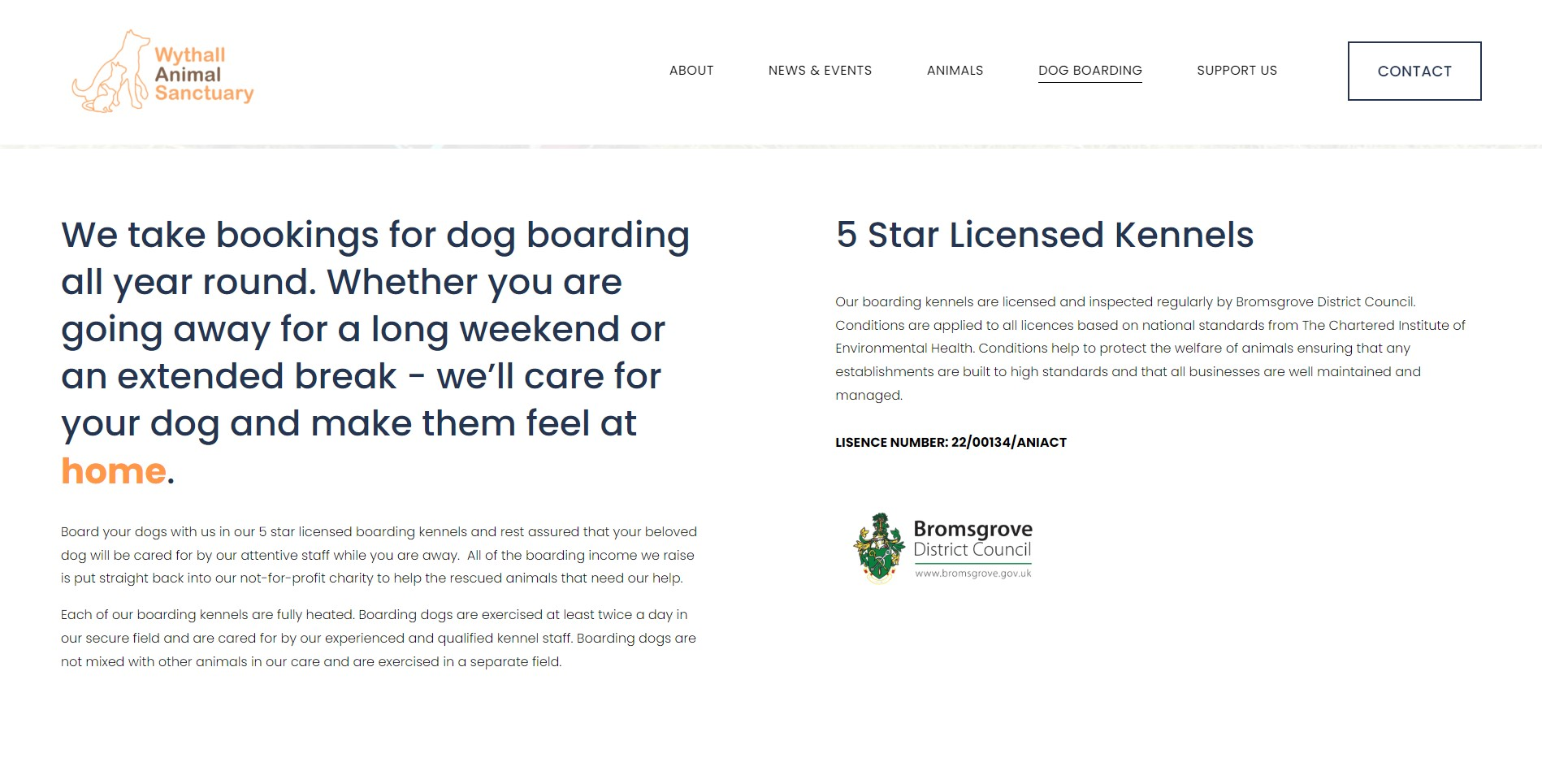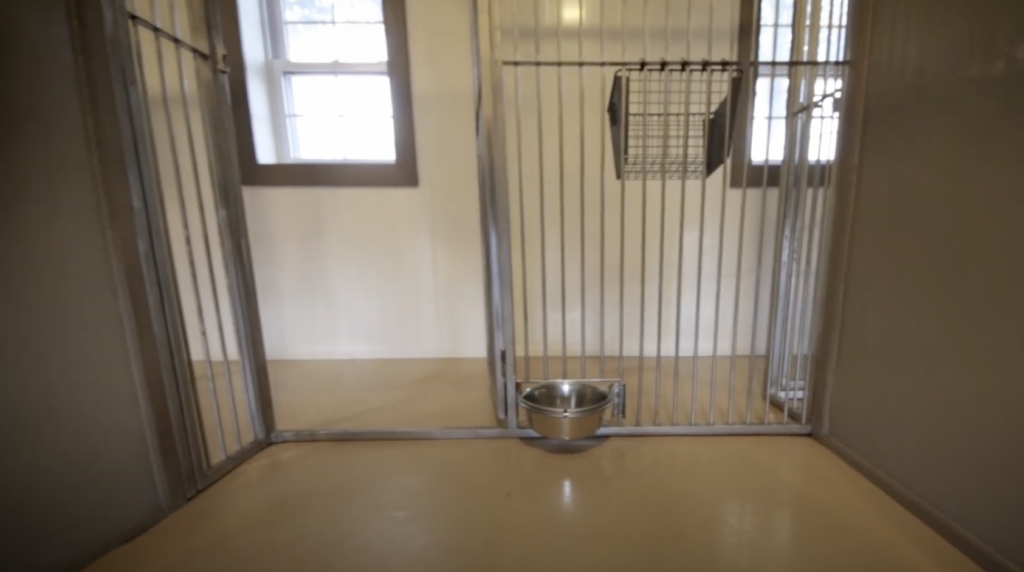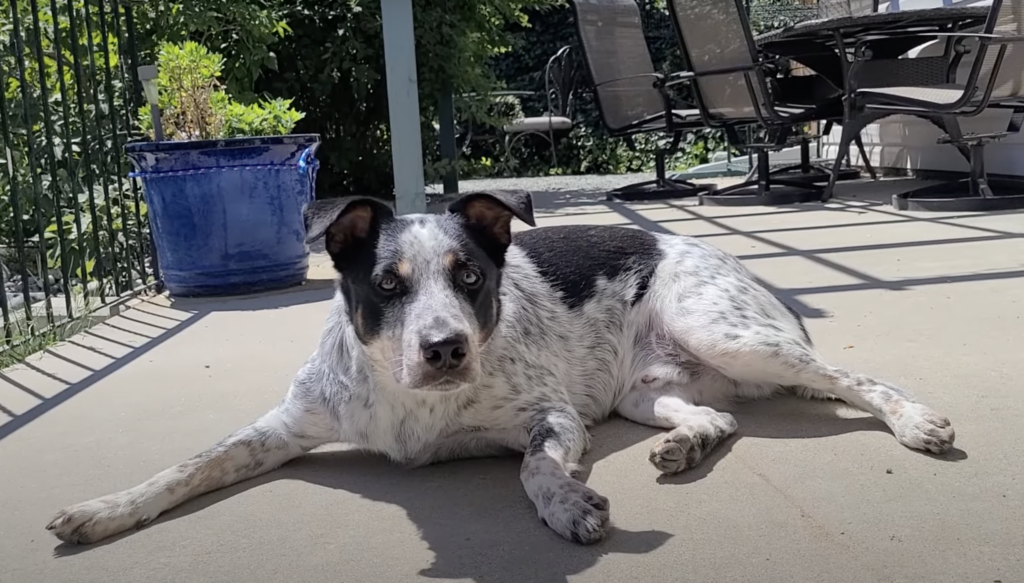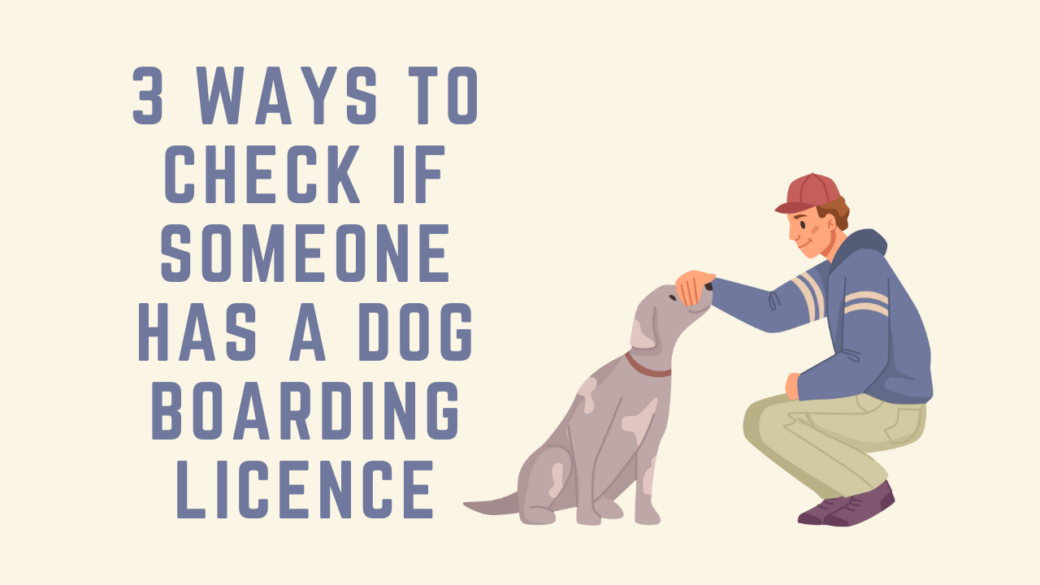When you need to use a boarding kennel or a home boarding service, as many people do, trusting another individual with your pet can be daunting. Of course, there are alternatives like dog walkers or sitters, but these options rarely offer the same level of 24/7 care that boarding establishments do.
However, when it comes to checking the credentials and reputation of the establishment or person boarding dogs, where do you begin? Thankfully, the UK has created legislation that states how these animal boarding services must run, and this includes receiving a dog boarding licence; this is a requirement for both boarding kennels and home boarding services. As the dog’s owner, it is up to you to confirm a licence has been awarded.
As this is vital to ensuring your dog will be cared for correctly, Household Pets has explored the three ways to check if someone has a dog boarding licence.
Table of Contents
What is a Boarding Licence?
To run a dog boarding kennel or cattery, a licence must be obtained. Doggy day care services also require a licence. A number of requirements must be met during the application process to be issued with a boarding licence, as outlined by the Animal Boarding Establishments Act 1963, including those working from a “private dwelling.” This licence will specify how many dogs or cats, if running a cattery, can be accommodated on the premises and other conditions.
Knowing a boarding facility is licensed can ease some of the nerves dog owners have when leaving their pets in someone else’s care.
How to Check if Someone Has a Dog Boarding Licence
Checking if the boarding kennel is licenced can sometimes take a little bit of research to find an answer, especially if some methods prove uncooperative. In most cases, the first check listed in this article will confirm the existence of a licence if the local authority has approved the home boarding or kennel.
Contact the Local Authority
Your first method of verifying the facility or individual has an animal boarding licence is to contact your local council. This can be a time-consuming check if the council’s website doesn’t clearly state where to find existing licences or how to contact the licensing team, which can be the case.
Most local authorities will list the email address, telephone number, or contact form to make an enquiry with the relevant team. For example, Manchester City Council has a “licences and permissions” page, which is easy to find from the website’s homepage; this webpage displays several options, one being “view public registers.” This option displays the public registers; the first listed is on animal boarding. It provides an email address you can contact to request an animal boarding licence.

Councils, like Falkirk Council, might also display the eligibility criteria of the boarding establishment’s licence. This local authority includes a document focusing on the basic conditions for providing home boarding, which can be used when visiting premises to ensure the home boarding business follows the guidance. This document includes the following points:
- No child under five resident.
- Only dogs from the same household can be boarded at any one time.
- Boarded dogs are to be kept on hard flooring – no carpets, but washable rugs are permitted.
- Direct access to a secure garden with fencing of at least 1.5 metres high for the sole use of the property. Gates must be locked/bolted from the inside…
- The register/booking form should contain:
- Name/description of dog
- Microchip number
- Dates of boarding
- Owner details
- Emergency contact details
- Vet contact details
- Vaccination history
- Health/welfare/nutrition requirements
- Date of last season, if applicable
- Medication
- A written agreement regarding emergency vet treatment
- A written agreement regarding sharing with the resident dog(s)
- A written record of familiarisation sessions with the resident dog(s)
- A written record of medication administered
Not all council websites will be so easy to navigate, but local authorities will provide the requested information if they are contacted; however, it will be a quicker process if you contact the correct department from the get-go.
Visit the Facility and Ask for Documentation
Licensed kennels and catteries should display their licence on the premises and be forthcoming in showing it to visitors. If someone is boarding dogs in their own home, then the individual should present the dog home boarding licence when asked. No matter if it is a kennel or home boarding business, staff members should be willing to discuss their current licence status.
When checking a boarding licence, be sure to look at the issue and expiry dates to ensure the kennel still has approval from the local authority inspectors. If the licence has expired, do not use the boarding facility; licences must be up-to-date to ensure the kennel or home boarder can legally care for other people’s dogs.
On the dog boarding service’s website, the licence might be mentioned. Some boarders, such as Wythall Animal Sanctuary in Birmingham, display their licence number, allowing potential customers to research and verify it with the local council.

Ask Other Pet Owners or Professionals
Dog owners and those who work in the animal care sector will likely have an opinion on local boarding services. The best person to ask is your vet. In a community, there is a good chance that the person running the kennel or home boarding dogs has visited the veterinary surgeon with their own pets, which gives the vet some insight. They might have also heard from other clients who have used the boarding service, which widens their knowledge of the standard of care provided and the legality of the business.
Other owners can also be asked, especially if you know they have used home boarding or kennels. Ask about their experience using the service, what they know about the boarding licence, and so on. If you don’t know anyone personally, you can even search for them online; several forums discuss dog boarders’ credentials, so it shouldn’t be difficult to find one related to your area. A good place to start looking for further advice is the dog boarding forums on petforums.co.uk.
As positive reviews can’t always be trusted, be on the lookout for negative testimonials. No business would ever publish a review that reflects poorly on their service, so chances are it was written by someone who was unhappy with the standard of boarding. Although this will not always be the majority’s experience, and it might not be entirely related to the licence, it is still worth knowing. There might even be a rare case where someone mentions the establishment has no licence.
What Other Factors Should You Consider When Selecting a Dog Boarding Service or Facility?
Although ensuring the dog boarding service, including those who home board dogs, has a licence is a priority, there are other aspects that you should check before deciding where to send your pet dog. Many of these factors can be reviewed when visiting the boarding premises, so it is important to ask to see the kennels or person’s home before booking your dog’s stay.
Are the Staff Knowledgeable?
If an establishment is providing boarding to dogs on business premises, there will often be multiple staff members. These people will be tasked with a range of jobs, including caring for and exercising the dogs, cleaning the premises, confirming bookings, contacting clients, and more. To care for multiple dogs at once and ensure their care is to a good standard, boarding staff need to understand canines and their needs. This should be proven by a formal qualification or relevant experience.
Some of the questions to ask when searching for a reputable boarding kennel can be found here, but you should also observe how staff talk about and treat the dogs in their care. Someone who understands a dog’s needs will often display better care towards the animals when working with them. They should be able to recognise the signs of behaviour changes, pain, and sickness.
As well as knowledgeable staff members on the premises, you should also enquire about the on-call vet. If medical treatment is required for a resident dog, the business will likely have its own veterinary surgeon to contact. Knowing which vet practice or individual this is and how the process works will ease your worries if the worst were to happen. And, if your dog requires medication, you must also check that a qualified person on the staff can administer it correctly.
What Safety Measures Are in Place?
As well as staffing and cleanliness, which will be further discussed later, there are additional safety measures boarding kennels should have in place. These measures should also be adapted to ensure an individual’s home is a suitable environment for home boarding dogs.
Pre-Booking Discussion With the Dog’s Owners
When a new dog owner thinks about using the boarding service, a thorough check of the dog’s individual needs should be completed. This can be done over the phone or in person, but it is a good way to ensure the owner feels secure in their decision and the boarder understands the type of care the dog needs.
The three most important issues to discuss are:
- The dog’s vaccination history, including boosters and Kennel Cough vaccines
- The dog’s behaviour; for example, has the dog displayed aggressive or anxious behaviour before?
- The dog’s dietary and medical needs
Adequate Space and Security
The premises should be secured throughout. Multiple barriers should be in place between the outside and where dogs are kept to prevent escapees. Similarly, the security for home boarding will require at least two barriers between resident dogs and any entrance or exit. This system should also help dog boarding facilities ensure resident dogs do not come into contact with animals from outside the premises. Even when home boarding, dog owners must be informed if multiple dogs from different households will be staying; this can only go ahead if there is written consent from each owner.
Dogs must be kept in non-communal spaces, such as individual kennel units, when not supervised by staff. Only dogs from the same household can share a kennel unit if the owner has asked for this and the space allows for it. There should be enough room for the dogs to turn around without touching the walls or each other, and they should be able to lie flat on the floor.

There should be a maximum number of 25 dogs to one staff member. If the welfare of the resident animals is compromised, the number of staff members should be considered in relation to the size of the premises, the type of dogs being cared for, etc.
CCTV or 24/7 Staff on the Premises
As well as the number of staff, it would be worthwhile checking if the facility has a staff member onsite at all times or if CCTV is used during the night. The Animal Activities Licence states, “All individual dogs must be checked at least once at an appropriate interval during the out-of-hours period (for example, between 6 pm and 8 am) by CCTV or in person.” The legislation also mentions that records of these checks must be kept.
Insurance
Many insurance providers have plans specifically for pet boarding. Although this isn’t a typical safety measure, it does enable coverage if something goes wrong. This type of insurance often covers the financial aspects relating to injury, whether an animal or staff member, caused by specific incidents, such as transporting pets or moving equipment.
Does the Boarding Facility Look Clean and Well-Maintained?
The Animal Activities Licence also outlines the standard of cleanliness that should be maintained in the facility, and this should be checked when visiting the premises in person. As part of the minimum standards, all occupied kennel units should be cleaned at least once per day. The entire unit should be disinfected once weekly or more often and also at every occupancy change.
Dogs should be given regular toileting opportunities with either a run attached to their units; if this is not possible, then the dog should be removed from its kennel a minimum of four times daily to relieve itself. This helps to minimise the risk of dog waste in the sleeping areas inside the kennel units, but faeces should be cleaned as often as required.
As well as cleanliness, the facility should meet certain criteria, such as noise levels, temperature, ventilation, and more. For example, the temperature of the sleeping area should be kept between 10°C and 26°C. This should be monitored continuously to ensure dogs are neither too cold nor too hot, and staff should know the signs dogs will show if kept at the incorrect temperature. You can verify these aspects with staff during your visit.
Ensure the Facility Complies With the Animal Welfare Legislation
Most kennels that allow dogs and their owners to visit prior to their booking will follow the practices set out by The Animal Welfare Act. A suitable environment for boarding dogs will include multiple kennel units, which consist of sleeping areas and exercise runs, for each dog; larger units can house dogs from the same household.
For home boarding, meeting the minimum standards is essential to be issued with a licence. As outside buildings cannot be used as kennels, meaning the animals must be kept inside the home, people who board dogs in their own homes must check they have enough room to accommodate several dogs. This means having space for sleeping areas, which will need to be in multiple rooms if there are multiple dogs, and a suitable exercise area.

There are other rules boarding facilities should follow, such as providing dogs with grooming as requested by the owner, mental stimulation, and regular exercise. If the dog boarder also runs a cattery, this should be separate from the dog kennels to avoid unnecessary stress.
To Sum Up
Before you start boarding your dog, you must research the reputation of the businesses and facilities in your area, including if they are licensed. This helps ensure your dog is cared for correctly and the business is being run legally. It can be a weight off your shoulders if you can verify that your local authority has approved the kennel, meaning it will likely follow the Animal Welfare legislation.
But how do you check if a boarding kennel or home boarding service has a licence? There are three main ways to verify this: contact your local authority, ask the owner of the facility for proof of documentation during a visit, or check with other pet owners and experts.
All boarding establishments need a licence, including those that offer home boarding. A dog home boarding licence is much like an ordinary boarding licence, but it will be slightly altered to suit the home environment. This does not mean that less care should be taken to ensure high standards, though. Kennels that have been licensed will have met specific conditions during the application and inspection process. These conditions should be checked when visiting the premises in person.

